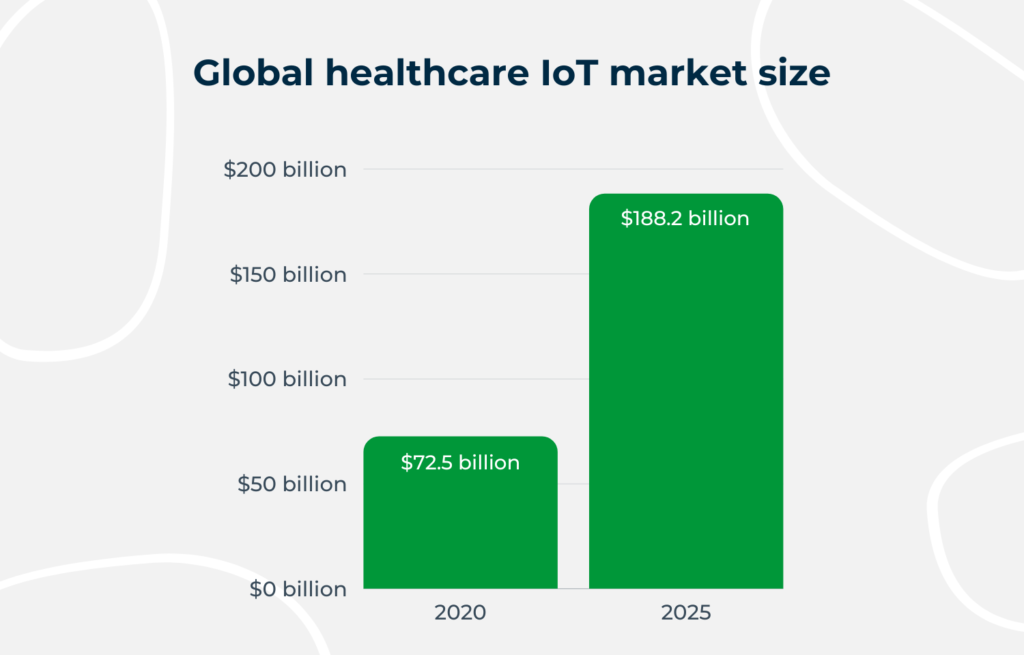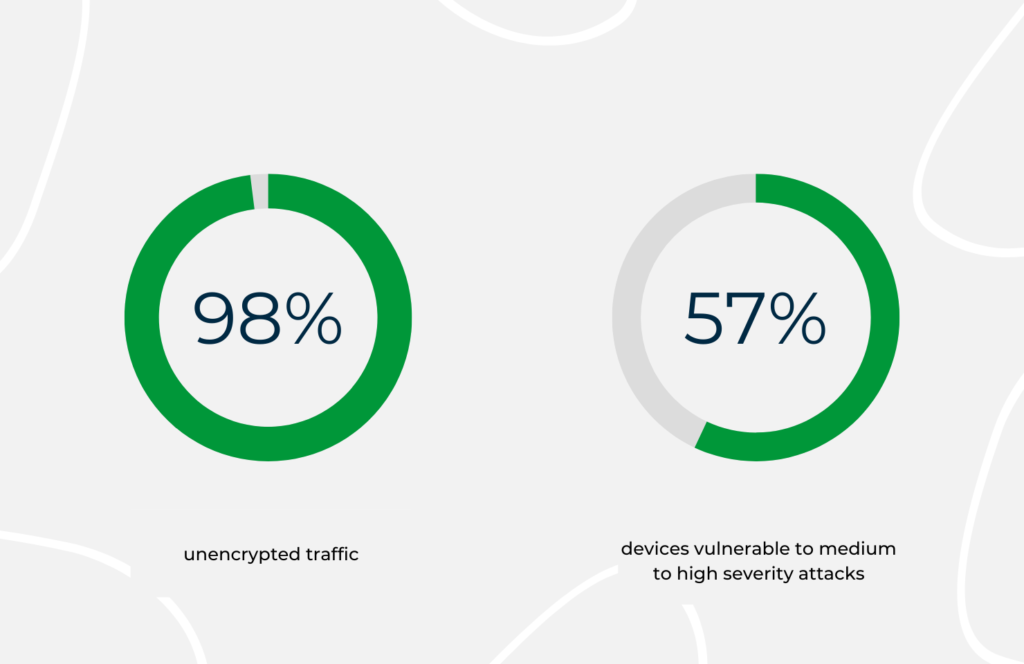
TABLE OF CONTENTS:
Today, more and more sectors benefit from ubiquitous digital technologies that transform every step of the user journey. This also entails taking advantage of the vast opportunities that effective data processing brings to the table. In this article, we will take a bit of a deeper dive into the healthcare industry. As one may imagine, a massive amount of information on patients, diseases, medications, treatment details, and so much more is generated on a daily basis. Healthcare is on the verge of a technological shift, and IoT is playing a central role.
From the perspective of an experienced healthcare IT service provider, we can definitely say a surge in interest in IoT technology is impossible to miss. Curious to find out how this sector can benefit from IoT technology and what threats you need to stay vigilant against? Then read on. We will go through some great examples of IoT healthcare solutions and devices that can help you elevate your business!
In recent years, we have witnessed a significant rise in technology being leveraged in healthcare. After all, let’s not forget the main trigger that accelerated the development of telemedicine was COVID-19. Doctors began to meet patients via videoconferencing to avoid the risk of infection, and e-prescriptions have become the new norm thanks to the pandemic. The growth in this field in just the past two years has increased the trust that both doctors and patients have in innovative tech solutions.
We believe the next revolutionary step in health-tech development is implementing IoT solutions that help monitor, collect, and analyze patient data (both current and historical). A number of forecasts and market studies also confirm this is where the industry is heading. For instance, Markets and Markets Research predicts that the global healthcare IoT market size will grow from $72.5 billion in 2020 to $188.2 billion by 2025.

The Internet of Medical Things (IoMT, also known as the Internet of Healthcare Things) is an ecosystem of connected devices and innovative technology healthcare solutions. What exactly does that mean? Essentially, these connected medical devices collect, process, share, and analyze data. Then they perform specific actions in real-time based on the data they collect. Such devices include smart glucose meters, thermometers, inhalers, and blood pressure monitors.
If you want to read more about IoT in general, check out this article: How IoT is Changing the World Around Us – the Future of the Internet of Things.
As we mentioned before, IoT medical devices collect and process huge amounts of patient data. Then, they communicate with each other and exchange the data, and in some cases, even take important actions that provide time-sensitive assistance. These devices can even save lives. Pretty cool, right?
Medical companies and patients want healthcare facilities to invest in IoT because these devices monitor health conditions in real-time and quickly consult a doctor. IoT helps prevent the progression of severe diseases by responding promptly when it identifies symptoms.
IoT healthcare solutions make diagnoses faster and more effective. Not only do these solutions help patients adhere to their treatment plans, but medical staff also receive more data about their patients. This allows them to make more informed, data-driven decisions about further treatment.
Thanks to technology such as modern blood glucose monitoring systems, patients can manage their disease better. They can also be taken care of faster and receive more accurate diagnoses. This results in less frequent hospital visits, contributing to their overall comfort and well-being
Processing various patient information on your own is a very time-consuming process. However, that’s not how it works with the Internet of Medical Things. IoT healthcare devices immediately send data directly to a cloud database. Then they analyze that information and generate reports to help patients better understand their health conditions. It helps patients and their team of doctors make better, data-driven decisions.
By implementing IoMT solutions, patient health data is constantly monitored without having to be in a hospital or medical facility. Overall, it reduces the number of doctor visits, hospital stays, and readmissions. That’s not the only cost-savings perk-small IoT devices are typically much cheaper than professional medical equipment. Trust us, this doesn’t mean they’re lower quality, they’re just less complex and focused on particular functionalities.
One of the primary benefits of using modern technology is the reduction of human errors due to fatigue, oversight, or simply wrong conclusions. Humans aren’t perfect, so of course, mistakes happen. However, in the medical field, human error can lead to painful consequences. Medical IoT can reduce such mistakes, and due to machine accuracy paired with the knowledge and experience of doctors, they significantly improve the accuracy of diagnoses.
The IoT enables healthcare providers to extend their care outside of the traditional clinical setting with remote control of implanted devices. For instance, software for an insulin pump allows you to modify parameters without visiting a medical facility.
IoT healthcare and medical devices generate, process, and analyze large amounts of protected patient information on a daily basis. Therefore, there is a constant challenge to create appropriate security policies and ensure the highest data protection standards for sensitive personal information against fraud.
Maintaining full connectivity between IoT devices is critical. Full connectivity ensures efficient and uninterrupted operation of your devices. Is this easy to achieve? No, not always. We recommend creating an efficient, scalable, and flexible network infrastructure that can minimize issues if they occur.
Be prepared for patients to ask about the scope of liability in case of possible malfunctions or errors with their devices. Currently, there are some laws defining the area of responsibility of various stakeholders. It follows that the software installed in IoT healthcare devices is responsible for the correct operation of the devices, i.e., the software provider. We recommend reviewing your country’s legal documents and regulations for details.
Another challenge you may face is related to healthcare IoT security. According to the latest Deloitte report, with more than one million enterprise and healthcare IoT devices, 98% of all traffic is unencrypted, and 57% of devices are vulnerable to medium to high severity attacks. So what should you do? Our best piece of advice is to use advanced data encryption systems that will be ensured by IoT providers experienced in these matters.

Just like all devices, IoT is vulnerable to technical failures. To minimize the risk of possible failures, it is worth working with a proven technology partner that cares about providing high-quality service and has similar projects and positive customer feedback in their portfolio.
As IoT systems can generate and process vast amounts of medical data, it can be challenging to store all of them. They certainly won’t fit on the computer disks available in medical facilities. Fortunately, there are cloud solutions that can solve this problem. According to a Deloitte report, more and more healthcare organizations are beginning to manage patient data in the cloud. Pioneering healthcare providers are even exploring new ways to use cloud-based HIPAA models to streamline medical treatments.
Are you looking for a technology partner with experience in the healthcare industry to help you create dedicated IoT products? Get in touch!
Our team has successfully completed many projects, including building embedded software for smart medical devices (e.g., an insulin pump and implanted defibrillators).
We know how important the security of medical data is, so we prioritize conducting many high-quality tests to verify the safety of the software we provide. Our products are compliant with class C requirements of the IEC 62304 standard for software for medical devices, making us a trusted and reliable technology partner you can count on.
